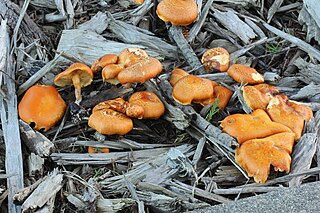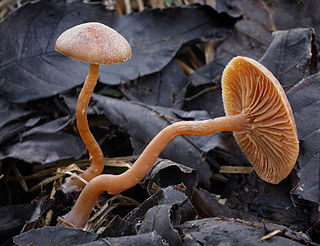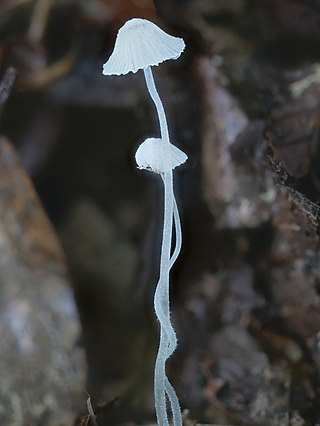
The Agaricaceae are a family of basidiomycete fungi and include the genus Agaricus, as well as basidiomycetes previously classified in the families Tulostomataceae, Lepiotaceae, and Lycoperdaceae.

Agaricus is a genus of mushroom-forming fungi containing both edible and poisonous species, with over 400 members worldwide and possibly again as many disputed or newly-discovered species. The genus includes the common ("button") mushroom and the field mushroom, the dominant cultivated mushrooms of the West.

Agaricus subrufescens is a species of mushroom, commonly known as almond mushroom, almond agaricus, mushroom of the sun, God's mushroom, mushroom of life, royal sun agaricus, jisongrong, or himematsutake. A. subrufescens is edible, with a somewhat sweet taste and a fragrance of almonds.
Allopsalliota is a fungal genus in the family Agaricaceae. A monotypic genus, it consists of the single species Allopsalliota geesterani, found in the Netherlands. The specific epithet honors Dutch mycologist Rudolph Arnold Maas Geesteranus. Allopsalliota was circumscribed in 1998 to contain what was then known as Agaricus geesterani, a species first described in 1986 by Cornelis Bas and Paul Heinemann.
Gymnopilus abramsii is a species of mushroom-forming fungus in the family Hymenogastraceae. It was first described by American mycologist Murrill in 1917. The epithet abramsii commemorates LeRoy Abrams.

Gymnopilus echinulisporus is a species of agaric fungus in the family Hymenogastraceae. It was first formally described by American mycologist William Alphonso Murrill in 1912.

Gyrophragmium is a genus of fungi in the family Agaricaceae. The genus was circumscribed by French botanist Camille Montagne in 1843.

Agaricus deserticola, commonly known as the gasteroid agaricus, is a species of fungus in the family Agaricaceae. Found only in southwestern and western North America, A. deserticola is adapted for growth in dry or semi-arid habitats. The fruit bodies are secotioid, meaning the spores are not forcibly discharged, and the cap does not fully expand. Unlike other Agaricus species, A. deserticola does not develop true gills, but rather a convoluted and networked system of spore-producing tissue called a gleba. When the partial veil breaks or pulls away from the stem or the cap splits radially, the blackish-brown gleba is exposed, which allows the spores to be dispersed.
Pluteus brunneidiscus is a species of agaric fungus in the family Pluteaceae. It was first described scientifically by American mycologist William Alphonso Murrill in 1917. It is found in Europe (Spain) and North America.

Tubaria is a genus of fungi in the family Tubariaceae. The genus is widely distributed, especially in temperate regions. Tubaria was originally named as a subgenus of Agaricus by Worthington George Smith in 1870. Claude Casimir Gillet promoted it to generic status in 1876. The mushrooms produced by species in this genus are small- to medium-sized with caps ranging in color from pale pinkish-brown to reddish-brown, and often with remnants of the partial veil adhering to the margin. Mushrooms fruit on rotting wood, or, less frequently, in the soil. There are no species in the genus that are recommended for consumption.

Agaricus hondensis, commonly known as the felt-ringed agaricus, is a species of fungus in the family Agaricaceae. The species was officially described in 1912 by mycologist William Alphonso Murrill, along with three other Agaricus species that have since been placed in synonymy with A. hondensis. Found in the Pacific Northwest region of North America, A. hondensis fruits in the fall under conifers or in mixed forests.

Lepiota castaneidisca is a species of agaric fungus in the family Agaricaceae. Formally described in 1912, it was for a long time considered the same species as the similar Lepiota cristata until molecular analysis reported in 2001 demonstrated that it was genetically distinct. It is most common in coastal and northern California, and has also been recorded in Mexico. A saprobic species, it is usually found under redwood and Monterey cypress. Its fruit bodies (mushrooms) have white caps with an orange-red to orange-brown center that measure up to 3.2 cm (1.3 in) wide. The cream-colored to light pink stems are up to 6.5 cm (2.6 in) long by 0.2–0.6 cm (0.1–0.2 in) thick, and have a ring. L. castaneidisca can be distinguished from other similar Lepiota species by differences in habitat, macroscopic, or microscopic characteristics.

Tricholoma fumosoluteum is a mushroom of the agaric genus Tricholoma. First described by Charles Horton Peck in 1875 as Agaricus fumosoluteus, it was transferred to the genus Tricholoma by Pier Andrea Saccardo in 1887.

Mycena alphitophora is a species of agaric fungus in the family Mycenaceae. Its small, white, delicate fruit bodies are characterized by the powdery coatings on the surfaces of both the cap and stipe. The stipe base is not swollen or disk-like. The stipe surface is more hairy than Mycena adscendens.
Leucocoprinus muticolor is a species of mushroom producing fungus in the family Agaricaceae.
Agaricus alabamensis is a North American species of mushroom in the genus Agaricus. This species is in the family Agaricaceae. Its spores have a dark chocolate color.
Amanita hygroscopia, also known as the pink-gilled destroying angel is a deadly poisonous fungus, one of many in the genus Amanita.

Agaricus alligator is a species of mushroom-forming fungus in the family Agaricaceae. It is endemic to the US. It was first described in 1945.











